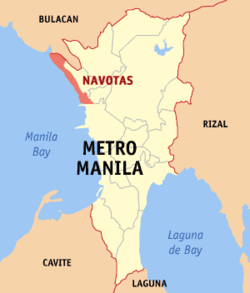Navotas
| Navotas | |||
|---|---|---|---|
| City | |||

Navotas as seen from Malabon
|
|||
|
|||
| Nickname(s): Fishing Capital of the Philippines | |||
| Motto: Itaas ang antas ng Buhay-Navoteño (Increase the level of the Navoteño's Life.) | |||
 Location within Metro Manila |
|||
| Location within the Philippines | |||
| Coordinates: 14°40′00″N 120°56′30″E / 14.6667°N 120.9417°ECoordinates: 14°40′00″N 120°56′30″E / 14.6667°N 120.9417°E | |||
| Country | Philippines | ||
| Region | National Capital Region | ||
| District | 1st to 2nd districts of Navotas | ||
| Established | December 20, 1827 | ||
| City | June 24, 2007 | ||
| Barangays | 14 | ||
| Government | |||
| • Type | Mayor–council | ||
| • Mayor | John Rey Tiangco (UNA) | ||
| • Vice Mayor | Clint Geronimo (UNA) | ||
| • Representatives |
Tobias Reynald M. Tiangco (UNA) 1st to 2nd districts of Navotas |
||
| • City Council |
Councilors
|
||
| Area | |||
| • City | 11.51 km2 (4.44 sq mi) | ||
| Population (2015 census) | |||
| • City | 249,463 | ||
| • Density | 22,000/km2 (56,000/sq mi) | ||
| Demonym(s) | Navoteño, Manilan | ||
| Time zone | PST (UTC+8) | ||
| ZIP code | 1409, 1411-1413, 1485, 1489-1490 | ||
| Area code | 2 | ||
| Website | www |
||
Navotas is a city in the Philippines located north of Manila. It is dubbed as the "Fishing Capital of the Philippines" because the livelihood of many of its residences were derived directly or indirectly from fishing and its related industries. Although it was established on December 20, 1827, Navotas celebrates its foundation day every January 16. Navotas became a city after a plebiscite was held on June 24, 2007.
The entire region of Navotas was once part of Malabon. According to one legend, the long and narrow delta extended unbroken from north to south along the seashore. The strip of land between the former district of Tondo, Manila and this town was eaten away by the sea until an opening was made. Water began to flow through the opening. The geographical change prompted the people to refer to the place as "butas", "nayon ng butas", or "nabutas", a Tagalog word that means breached or pierced through. What began as a natural channel developed into a regular waterway, now known as the Navotas River. In later years, the place came to be known as "Nabotas", then "Navotas".
It was also known as Hacienda de Navotas; it was once owned by the Dominican friars until it was sold to the Pascual family during the early days of the American regime and developed into a residential estate.
San Jose de Navotas was the name given to the locality after its patron saint, Saint Joseph. On June 11, 1859, a "Superior Decreto" established a new parish and municipality under the supervision of Friar Matias Navoa. The populace was divided into two distinct groups, the naturales (locals) and the mestizos. Mariano Estrellas was the gobernadorcillo (petty governor) of the naturales and Mariano Israel, of the mestizos. Today, because records are incomplete, recognition is only given to the gobernadorcillos for the mestizos. A school in honor of San Jose was built and known as "San Jose Academy."
Navotas was originally a contiguous part of Malabon and was not separated from it by a body of water. However, sometime in the past, the turbulent waters of Manila Bay gradually eroded a weak strip of land between this town and the district of Tondo in Manila until an opening was breached. Seawater continued to flow in through this opening particularly during high tide eventually carving out the Navotas River in the process. The channel created eventually developed into a regular waterway that has come to be known as the Navotas River. This natural phenomenon seemed to be the origin of the name that today is associated with this area, continually referred to as “nabutas” which over the time gradually evolved into “Navotas”, literally meaning “pierced through” in English. The original name bestowed to the place in its early history when it was still part of Malabon was San Jose de Navotas, in honor of its patron saint, San Jose. In 1827, the principales of San Jose de Navotas and Bangkulasi petitioned the Spanish government for the consolidation and separation of their barrios from Malabon to form a new town. This action was precipitated by the difficulty encountered by the townsfolk of these two barrios in transacting business and attending the church due to the physical separation brought by the Navotas River. The petition did not meet with success until three decades later when in February 16, 1859 as evidence by existing documents, the barrios of San Jose de Navotas and Bangkulasi was separated from Malabon. Eventually the Royal Audiencia promulgated the “Superior ” on June 11, 1859 which provided for the establishment of a new parish with a church and parochial school for the benefit of the town of Navotas and its barrios, which at that time were San Jose, Tangos, Bangkulasi and Tanza. Navotas was incorporated into the newly created Province of Rizal on June 11, 1901 through the enactment of Philippine Commission Act No. 137. However, pursuant to its policy of economy and centralization, the Philippine Commission again merged Malabon and Navotas through Act No. 942 designating the seat of government to Malabon.
...
Wikipedia



